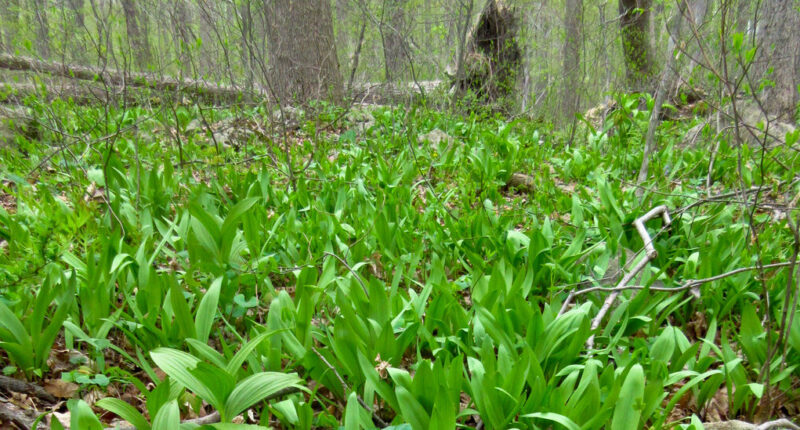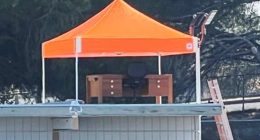
Jared Rosenbaum knows the primal thrill of foraging — a sense of interdependence with the natural world that he wants his son to experience, too.
But as a field botanist, he also understands that foraging is one of the many pressures on native-plant populations. And he has a proposition for gardeners: What if we gave back to the wild edible plants that tempt us on our springtime woodland hikes, by welcoming them into the landscapes we cultivate?
It’s one layer of the habitat restoration and ecological design inspiration that he and his wife, Rachel Mackow, provide to clients of Wild Ridge Plants, in rural Pohatcong Township, N.J. And it’s reflected in many of their mail-order nursery’s plant choices, too.
In Mr. Rosenbaum’s recent book, “Wild Plant Culture: A Guide to Restoring Edible and Medicinal Native Plant Communities,” he revisits that idea: “The time has come to reconnect with our habitats, right where we live, work, and play,” he writes. “Not as museum pieces, but as vital, sustaining elements in our lives, livelihoods, and lifeways.”
That includes our gardens. “These are native plants’ once and future habitats,” Mr. Rosenbaum said in a recent interview, “the places where they used to reside that we have excluded them from for so long. One way to help these plants is to garden with them.”
“With foraging,” he added, “the connection can be very one-sided. It’s not relationship, and it’s not interdependency.”
On his list for building “food habitats” are not just native fruiting shrubs and trees like blueberries, elderberries, beach plums, persimmons and pawpaws, but also herbaceous perennials with edible features.
Could you make room for homegrown wild leeks (Allium tricoccum), otherwise known as ramps? Or ostrich fern (Matteuccia struthiopteris), whose at once crunchy and tender fiddleheads with their crazy spiral geometry make for a unique mouthfeel?
And did you know that wildflowers you may already be growing — including giant Solomon’s seal (Polygonatum biflorum var. commutatum) and the cutleaf, or tall, coneflower (Rudbeckia laciniata) — likewise have springtime garden-to-table potential?
Time to dig in, in the garden and at the table.
Consider the Plight of Ramps
Native plant communities suffer as human development continues to degrade and eliminate habitats. Wild collecting is just one pressure — but it’s one Mr. Rosenbaum contends that gardeners can counteract.
He uses wild leeks, or ramps, as a poster child for the bigger message. In its fleeting moment each spring, that ephemeral woodland ground cover has become the star of restaurant menus. And the resulting demand has only intensified pressure on the plant’s population.
Gardeners may be familiar with the plight of charismatic native woodland wildflowers like Trillium, but the story of ramps is not so different. Both plants have been overharvested, and both rebound slowly, if they do rebound, because they are very slow to establish, requiring many years to reach reproductive maturity from seed. Ramps can take five years to rebound before they eventually colonize and form bulbs underground.
“So how many decades’ worth of wild leeks’ life can you eradicate in an hour with a shovel, going into a wild patch and digging them all up?” Mr. Rosenbaum asked. “It’s sort of staggering.”
In spring, the bulbs send up long, strap-like leaves resembling those of lily of the valley, but with a characteristic alliaceous odor. By late spring, they basically disappear underground until late summer, when flowers emerge, followed by seed production in fall.
The seeds, which resemble tiny black marbles, Mr. Rosenbaum said, are “very dispersal-limited” — meaning that they are not moved by helpers like the wind, or covered in fruit to attract birds that will eat them and fly off, planting the excreted seed elsewhere. Deer mice may cache and move some of the seeds, but only a short distance.
“If wild leeks are in one forested area, and there’s suitable habitat across the road, they are not necessarily going to get there on their own,” Mr. Rosenbaum added. “And so we humans become a potentially excellent dispersal agent, and we’re really good at identifying suitable habitats.”
He and Ms. Mackow have seeded them in shady areas around their farm.
Rather than digging wild leeks in the wild, he suggests ordering seeds or seedlings and using your shovel to prepare what he calls “woodsy beds” for them. Identify an area that’s at least a little bit shaded, beneath deciduous trees or shrubs.
“Then amend it with your more woodland soil-building blocks: leaf compost, a thin layer of wood chips,” he said. “Just try to build up that kind of dark, moisture-retentive organic soil like you would find in a higher-quality woodland.”
Because ramps’ foliage fades after the spring show, Mr. Rosenbaum suggests pairing them with a plant that will perform a second act in the space: spikenard (Aralia racemosa), for example, or black cohosh (Actaea racemosa). Or maybe the little-grown poke milkweed (Asclepias exaltata), found on forest edges.
Once your patch is established, manage the ramps sustainably, harvesting only one or two leaves from each mature plant (and never digging the bulbs).
More Unexpected Spring Greens
Mr. Rosenbaum is looking forward, any day now, to chopping a few ramps and folding them into an omelet or cooking them with some homegrown morels, “just this killer wild-foods combination of the local bioregional spring,” he said.
Who knew that quickly frying ramps leaves in a skillet with some oil makes them balloon up like little corn tortillas? They are also great sautéed in a pan with fiddleheads, the unopened foliage of the ostrich fern, whose season is approaching. (But cooking with fiddleheads can be toxic, so be sure to wash them well and never eat them raw: Always boil them before you sauté or cook them in any other way.)
Anyone who has grown the ostrich fern knows that it is a mover, inclined to colonize. But isn’t that what we often want from a deer-resistant, shady ground cover in workhorse situations — along property edges or in other spaces that we may have unthinkingly filled with the likes of pachysandra or English ivy?
Once unfurled, the ostrich fern’s prehistoric-looking, plume-shaped fronds can stand three feet tall — and will sometimes grow as high as six feet — making them a lot more dramatic than any aggressive, alien ground cover.
But picking too many fiddleheads from an individual plant will reduce its productivity in subsequent years, which is why Mr. Rosenbaum never harvests more than one or two from any individual plant.
Of equally impressive stature, at up to seven feet tall, is giant Solomon’s seal, which has arching stems that hold little white, bell-like flowers in spring and blue fruit in fall. The unopened shoots can be selectively harvested, as you would an ostrich fern’s.
“When it’s still this upright shoot, and the leaves are still tightly clasped at the top, it’s tender and edible,” Mr. Rosenbaum said.
It’s no surprise that Solomon’s seal is in the asparagus family, as its shoots taste somewhat similar to that spring standard.
Mr. Rosenbaum is a champion of a wilder wild creature, too: the Canadian wood nettle (Laportea canadensis), an important host plant of various native butterflies. But gardeners may wish to relegate it to an out-of-the-way spot, as it has stinging hairs like its also-edible botanical cousin, the stinging nettle (Urtica dioica).
Wearing gloves and long sleeves, pick the shoots when they are about six inches high. Then cook them before eating, to destroy the stinging power.
One wild plant that is not well known as an edible, Mr. Rosenbaum said, is the cutleaf, or tall, coneflower — as in, up to nine feet tall. The gold flowers held aloft aren’t what you harvest: The fresh, emerging leaves, known by the Cherokee people as sochan, are the culinary prize.
This plant, which shows up even earlier than dandelions, is perhaps the earliest edible of all, Mr. Rosenbaum said. He harvests leaves from the basal rosette when it’s about two to four inches high.
The plant, adaptable from partial shade to full sun, spreads, too. “I’d give it its own exclusive patch,” Mr. Rosenbaum said.
Then he thought again, offering another suggestion: Try planting it with ostrich fern and giant Solomon’s seal, which hail from the same kind of spots. “That would be a great combination,” he said, “dreamily replicating a little slice of nature that I have never yet gotten to see.”
A Couple of Tubers to Dig
A very different harvest, usually toward season’s end, comes from two natives that form edible underground tubers.
Jerusalem artichoke, or sunchoke, a perennial sunflower, will try to outdo even the tall coneflower in height and inclination to spread. And like the tall coneflower, it will provide a feast for pollinators and birds.
American groundnut (Apios americana) offers another kind of vertical element, scrambling up an elderberry shrub, for example, or a proper trellis. The twining herbaceous perennial vine is a host plant for the silver-spotted skipper butterfly, and produces flowers in rosy shades, with a shape that reveals the plant’s membership in the pea family. The tubers are potato-like, but have more of a bean or nutty flavor.
Part of Mr. Rosenbaum’s work is conducting field studies for public and private clients, and he estimates that he has surveyed more than 15,000 acres in New Jersey. During his work, he has come across many precious scenes, but too often what he sees are the remains of once-vibrant colonies. That has left an indelible impression.
He writes of his “desire to see wild plants and humans share community again,” and is moved to tell plants’ stories in the hope that they will find homes in a wider area.
“Gardeners,” Mr. Rosenbaum noted, “can be at the vanguard of ecological restoration.”
Prepare for a wild and delicious ride.
Margaret Roach is the creator of the website and podcast A Way to Garden, and a book of the same name.
For weekly email updates on residential real estate news, sign up here.
Source: | This article originally belongs to Nytimes.com









